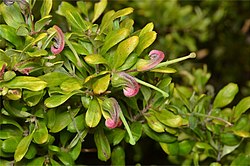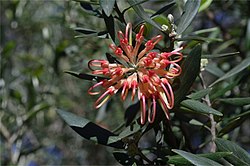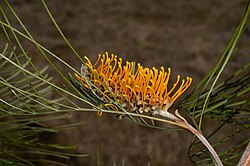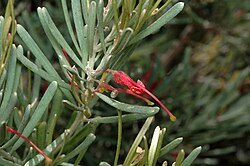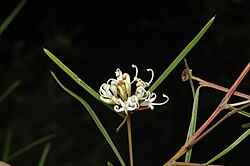A-C
| Common and scientific names [1] | Subspecies [1] | Distribution [1] [2] | IUCN status [2] | Other statuses [3] [4] [5] | Image |
|---|---|---|---|---|---|
| Grevillea acacioides C.A.Gardner ex McGill. | W.A. | |  | ||
| Acanthus-leaved grevillea Grevillea acanthifolia A.Cunn. |
| N.S.W. | | Endangered (subsp. paludosa)(EPBC) |  |
| Grevillea acerata McGill. | N.S.W. | |  | ||
| Grevillea acrobotrya Meisn. | W.A. | |  | ||
| Grevillea acropogon Makinson | W.A. | | Endangered (EPBC) Threatened (Declared Rare Flora) – Extant Taxa (DEC) |  | |
| Grevillea acuaria F.Muell. ex Benth. | W.A. | |  | ||
| Grevillea adenotricha McGill. | W.A. | | Priority Four — Rare Taxa (DEC) | ||
| Blue grevillea Grevillea agrifolia A.Cunn. ex R.Br. |
| W.A, N.T. | |  | |
| White spider flower Grevillea albiflora C.T.White | N.S.W, QLD, S.A, N.T. | |  | ||
| Alpine grevillea Grevillea alpina Lindl. | N.S.W, A.C.T, VIC. | |  | ||
| Buffalo grevillea | VIC. | Critically Endangered (FFG) |  | ||
| Split-leaved grevillea Grevillea althoferorum Olde & Marriott |
| W.A. | Endangered (EPBC) Threatened (Declared Rare Flora) – Extant Taxa (both subsp.) (DEC) |  | |
| Grevillea amplexans F.Muell. ex Benth. |
| W.A. | | Priority One (subsp. adpressa)(DEC) Priority Two (subsp. semivestita)(DEC) |  |
| Spiny cream spider flower | W.A. | |  | ||
| Red Lake grevillea Grevillea aneura McGill. | W.A. | | Priority Four — Rare Taxa (DEC) | ||
| Grevillea angulata R.Br. | N.T. | |  | ||
| Dissected holly-leaf grevillea Grevillea angustiloba (F.Muell.) Downing |
| S.A, VIC. | | Endangered (subsp. angustiloba) (FFG) Critically Endangered ( subsp. wirregaensis) (FFG) |  |
| Prickly plume grevillea Grevillea annulifera F.Muell. | W.A. | | Priority Three – Poorly Known Taxa (DEC) |  | |
| Holly grevillea Grevillea aquifolium Lindl. | S.A, VIC. | |  | ||
| Sand grevillea Grevillea arenaria R.Br. |
| N.S.W. | |  | |
| Silvery-leaved grevillea Grevillea argyrophylla Meisn. | W.A. | |  | ||
| Prickly toothbrushes Grevillea armigera Meisn. | W.A. | |  | ||
| Grevillea asparagoides Meisn. | W.A. | | Priority Three — Poorly Known Taxa (DEC) |  | |
| Rough grevillea Grevillea aspera R.Br. | S.A, W.A. | | Priority One — Poorly Known Taxa (DEC) |  | |
| Fern leaf grevillea Grevillea aspleniifolia Knight | N.S.W. | |  | ||
| Star-leaf grevillea Grevillea asteriscosa Diels | W.A. | | Priority Four — Rare Taxa (DEC) |  | |
| Golden grevillea Grevillea aurea Olde & Marriott | N.T. | |  | ||
| Alpine grevillea Grevillea australis R.Br. | N.S.W, A.C.T, VIC, TAS. | |  | ||
| Banks' grevillea Grevillea banksii R.Br. | QLD. | |  | ||
| Banyabba grevillea Grevillea banyabba Olde & Marriott | N.S.W. | | Vulnerable (EPBC) |  | |
| Gully grevillea Grevillea barklyana F.Muell. ex Benth. | VIC. | Critically Endangered (FFG) |  (Hybrid) | ||
| Mount Lesueur grevillea Grevillea batrachioides F.Muell. ex McGill. | W.A. | Endangered (EPBC) Threatened (Declared Rare Flora) – Extant Taxa (DEC) |  | ||
| Bauer's grevillea Grevillea baueri R.Br. |
| N.S.W. | |  | |
| Cape Arid grevillea Grevillea baxteri R.Br. | W.A. | | Priority Four — Rare Taxa (DEC) |  | |
| Beadle's grevillea Grevillea beadleana McGill. | N.S.W. | Endangered (EPBC) |  | ||
| Red combs Grevillea beardiana McGill. | W.A. | |  | ||
| Enfield grevillea Grevillea bedggoodiana J.H.Willis ex McGill. | VIC. | Vulnerable (EPBC) Endangered (FFG) |  | ||
| Grevillea bemboka Stajsic & Molyneux | N.S.W. | |  | ||
| Grevillea benthamiana McGill. | N.T. | |  | ||
| Grevillea berryana Ewart & Jean White | W.A. | | |||
| Grevillea biformis Meisn. |
| W.A. | | Priority Two – Poorly Known Taxa (subsp. cymbiformis) (DEC) |  |
| Fuchsia grevillea Grevillea bipinnatifida R.Br. |
| W.A. | | Priority One – Poorly Known Taxa (subsp. pagna ms) (DEC) |  |
| Grevillea biternata Meisn. | W.A. | |  | ||
| Grevillea brachystachya Meisn. | W.A. | |  | ||
| Short-styled grevillea Grevillea brachystylis Meisn. |
| W.A. | | Critically Endangered (subsp. grandis)(EPBC) Vulnerable (subsp. australis) (EPBC) Threatened (Declared Rare Flora) – Extant Taxa (Subsp. australis) (DEC) Priority Three (DEC) (subsp. brachystylis) |  |
| Bracted grevillea Grevillea bracteosa Meisn. |
| W.A. | Critically Endangered (subsp. howatharra) (EPBC) Threatened (Declared Rare Flora) – Extant Taxa (both subsp.) (DEC) |  | |
| Cobberas grevillea Grevillea brevifolia F.Muell. ex Benth. | N.S.W, VIC. | | Endangered (FFG) |  | |
| Grevillea brevis Olde & Marriott | N.T. | | |||
| Grevillea bronweniae Keighery | W.A. | Priority Two — Poorly Known Taxa (DEC) |  | ||
| Burrowa grevillea Grevillea burrowa Molyneux & Forrester | VIC. | Critically Endangered (FFG) and (EPBC) |  | ||
| Grey spider flower Grevillea buxifolia (Sm.) R.Br. |
| N.S.W. | |  | |
| Grevillea byrnesii McGill. | W.A, N.T. | |  | ||
| Red toothbrushes Grevillea cagiana McGill. | W.A. | |  | ||
| Grevillea calcicola A.S.George | W.A. | | Priority Three — Poorly Known Taxa (DEC) | ||
| Caley's Grevillea Grevillea caleyi R.Br. | N.S.W. | | Critically Endangered (EPBC) |  | |
| Foote's grevillea Grevillea calliantha Makinson & Olde | W.A. | | Endangered (EPBC) Threatened (Declared Rare Flora) – Extant Taxa (DEC) |  | |
| Mt. Benambra grevillea Grevillea callichlaena Molyneux & Stajsic | VIC. | Critically Endangered (FFG) |  | ||
| Grevillea candelabroides C.A.Gardner | W.A. | |  | ||
| Grevillea candicans C.A.Gardner | W.A. | | Priority Three — Poorly Known Taxa (DEC) |  | |
| Toodyay grevillea Grevillea candolleana Meisn. | W.A. | Priority Two — Poorly Known Taxa (DEC) |  | ||
| Grevillea capitellata Meisn. | N.S.W. | | |||
| Nowa Nowa grevillea, Colquhoun grevillea Grevillea celata Molyneux | VIC. | Vulnerable (EPBC) Critically Endangered (FFG) |  | ||
| Grevillea centristigma (McGill.) Keighery | W.A. | |  | ||
| Grevillea ceratocarpa Diels | W.A. | | |||
| Grevillea cheilocarpa Makinson | W.A. | | |||
| Christine's grevillea Grevillea christineae McGill. | W.A. | | Endangered (EPBC) Threatened (Declared Rare Flora) – Extant Taxa (DEC) |  | |
| Golden grevillea Grevillea chrysophaea F.Muell. ex Meisn | VIC. | Vulnerable (FFG) |  | ||
| Varied-leaf grevillea Grevillea cirsiifolia Meisn. | W.A. | |  | ||
| Grevillea coccinea Meisn. |
| W.A. | | Priority Three — Poorly Known Taxa (DEC) (Subsp. lanata) |  |
| Grevillea commutata F.Muell. |
| W.A. | |  | |
| Red combs, elegant grevillea Grevillea concinna R.Br. |
| W.A. | |  | |
| Grampians grevillea, dense-leaf grevillea Grevillea confertifolia F.Muell. | VIC. | Endangered (FFG) |  | ||
| Grevillea corrugata Olde & Marriott | W.A. | | Endangered (EPBC) Priority One – Poorly Known Taxa (DEC) |  | |
| Grevillea costata A.S.George | W.A. | | Priority Three — Poorly Known Taxa (DEC) |  | |
| Grevillea crassifolia Domin | W.A. | | |||
| Grevillea cravenii Makinson | W.A. | | Priority Two — Poorly Known Taxa (DEC) | ||
| Grevillea crithmifolia R.Br. | W.A. | |  | ||
| Grevillea crowleyae Olde & Marriott | W.A. | | Priority Two — Poorly Known Taxa (DEC) | ||
| Grevillea cunninghamii R.Br. | W.A. | | |||
| Grevillea curviloba McGill. |
| W.A. | | Endangered (Both subsp.) (EPBC) Threatened (Declared Rare Flora) – Extant Taxa (both subsp.) (DEC) |  |
| Carnarvon grevillea, green grevillea Grevillea cyranostigma McGill. | QLD. | |









































































































